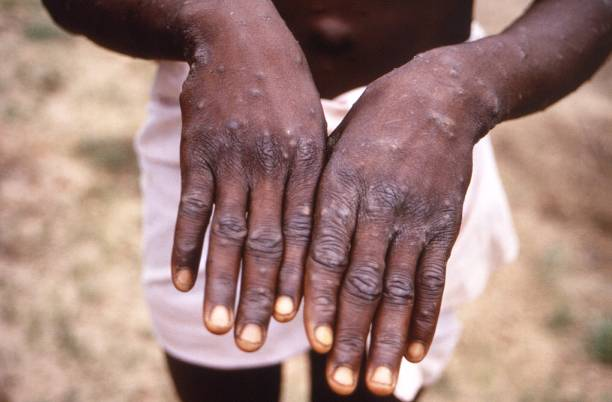
On August 22, 2024, the National Public Health Institute reported (1:54 minutes) six suspected cases of monkeypox in Liberia with no mortality.
Dr. Dougbeh Chris Nyan said there is a need to consider the reactivation of surveillance and response for passengers at the National Airport and border crossing points.
“There is a need to reactivate the triage at the airport and other ports of entry; we have taken measures to encourage NPHIL staff to keenly look at the vaccination record and do an assessment of travelers so we don’t have a mass outbreak like in East Africa.”
He said, “We have been having cases, but we want to avoid an outbreak. We are working with international partners, including the Africa Centre for Disease Control and the World Health Organization. We want the public to be vigilant and aware that there is a need to continue public awareness nationwide.”
What is monkeypox?
According to the Centres for Disease Control and Prevention (CDC), pox (formerly known as monkeypox) is a disease caused by infection with a virus known as the monkeypox virus. This virus is part of the same family of viruses that cause smallpox.
Mpox is a zoonotic disease, meaning it can be spread between animals and people. It is endemic or found regularly in parts of Central and West Africa. The virus that causes monkeypox has been found in small rodents, monkeys, and other mammals that live in these areas.
The World Health Organisation (WHO) has said the monkeypox virus is an orthopoxvirus that causes pox (monkeypox), a disease with symptoms similar to smallpox, although less severe.
While smallpox was eradicated in 1980, it continues to occur in countries in central and western Africa.
How does the monkeypox virus transmit?
According to the WHO, Mpox spreads from person to person through close contact with someone who is infected with the monkeypox virus. Close contact includes being face-to-face (such as talking or breathing close to one another, which can generate droplets or short-range aerosols); skin-to-skin (such as touching or vaginal/anal sex); mouth-to-mouth (such as kissing); or mouth-to-skin contact (such as oral sex or kissing the skin).
The CDC indicates that both clades of pox spread through direct contact with infected wild animals, through close contact, including intimate or sexual contact with a person with pox, and through contact with contaminated materials.
Similar analyses can also be found here, here, and here.
What are the signs and symptoms of monkeypox?
People with pox often get a rash that may be located on hands, feet, chest, face, or mouth, or near the genitals, including the penis, testicles, labia, vagina, and anus, according to the CDC.
The first symptom of monkeypox is a rash, while others may have different symptoms first. The rash begins as a flat sore, which develops into a blister filled with liquid and may be itchy or painful. As the rash heals, the lesions dry up, crust over, and fall off. Some people may have one or a few skin lesions, and others may have hundreds or more. These can appear anywhere on the body, such as the palms of hands and soles of feet, face, mouth, throat, groin and genital areas, and anus.
Some people also have painful swelling of their rectum or pain and difficulty when peeing. More information can also be found here and here.
Besides, the WHO factsheet indicates that the signs and symptoms of a person infected with monkeypox usually begin within a week but can start 1 to 21 days after exposure. However, the symptoms typically last 2 to 4 weeks and sometimes longer in someone with a weakened immune system.
How can monkeypox be detected and treated?
According to the Cleveland Clinic, to diagnose mpox, the healthcare provider takes a tissue sample from an open sore (lesion). Then, send it to a lab for polymerase chain reaction (PCR) testing genetic fingerprinting.
In addition to that, the person affected also needs to give a blood sample to check for the monkeypox virus or antibodies the immune system makes.
Currently, there are not any approved antiviral treatments for monkeypox. However, antiviral drugs like cidofovir or tecovirimat may be prescribed to the sick person by a healthcare provider.
How can monkeypox be prevented?
The CDC recommends the JYNNEOS vaccine for the prevention of pox. Getting both doses provides the best protection. A person should get two doses four weeks apart. Even if it has been longer than 4 weeks since the first vaccine dose, one needs to get the second dose as soon as possible.
However, if a Mpox patient has previously recovered from Mpox, he or she does not need the vaccine.
On the other hand, NPHIL encouraged the public to adhere to the following public health preventive measures:
· Avoid close contact with an infected person.
· Use personal protective equipment (PPE) when caring for patients.
· Do not share bedding, clothing, towels, or utensils with sick people.
· Practice hand hygiene and respiratory etiquette.
· Isolate infected patients in hospitals or at home.
· Avoid close contact with wild animals, especially those found sick or dead.
· Cook all foods containing fresh animal meat or products properly before eating.
What is WHO saying?
WHO Director-General, Dr Tedros Adhanom Ghebreyesus, declared the pox outbreak a public health emergency of international concern on August 14, 2024. The WHO noted that the declaration makes it easier to speed up the acquisition and implementation of funding, global public health measures, and joint efforts to contain the disease. The WHO advisory on Mpox is also found here.
Conclusion: With the declaration of monkeypox as a public health emergency of international concern by the WHO, Liberia has confirmed six suspected cases of the disease with no deaths
Meanwhile, Dr. Nyan disclosed that the 6 cases were identified and have been treated and discharged since July 2024.




